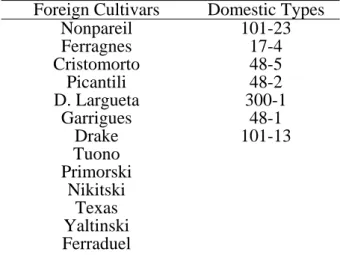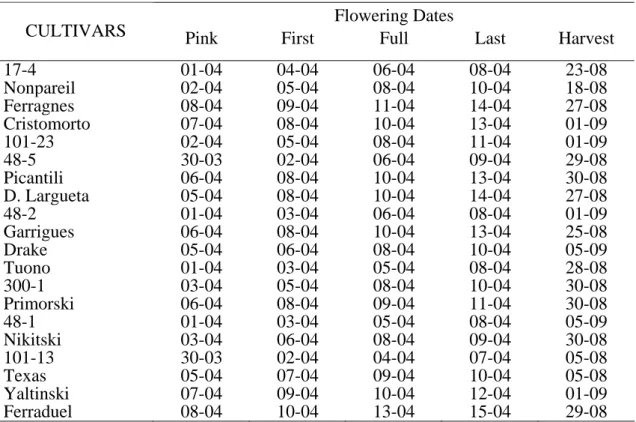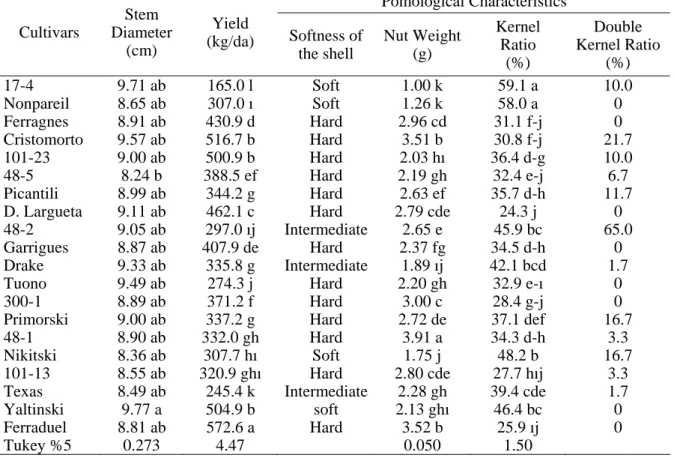Comparison of Growth, Bearing, Yield and some Quality
Charac-teristics of Different Almond Cultivars under Irrigated Conditions
H.S. Atli, I. Acar, S. Arpaci, A. Akgun, Y. Aydin and C. BilimPistachio Research Institute, Gaziantep.
Keywords: Almond, Adaptation, Yield, Quality, Irrigated condition. Abstract
This experiment was carried out in order to determine the best almond cultivars for irrigated areas in Gaziantep, Turkey. The experimental orchard was established at 3 × 5 m in spacing in 1998. Twenty almond cultivars and types were used as material based on tree growth, bearing, yield and some quality characteristics. The best diameter growth of trunk was occurred on Yaltinski cultivar. The highest yield per decare (0.1 ha.) was obtained from Ferraduel (572.6 kg), Cristomorto (516.7 kg), Yaltinski (504.9 kg) and 101-23 (500.9 kg) in 2003. INTRODUCTION
Turkey is the 9th almond producer country in the world with 40.000 tons production (Table 2). Although climatic condition is suitable for almond growing, the production of almond is low in Turkey. Almond gets good income from domestic and foreign markets. To spread almond production, favorable almond cultivars ought to be determined for irrigated areas of the Southeast Anatolia Region in Turkey.
This project has been carried out in order to to determine the best almond cultivars suitable for climatic condition of the Southeast Anatolia region.
MATERIALS AND METHODS
In this study, thirteen foreign and seven domestic almond cultivars and types have been used as material (Table 1). The experimental orchard was established at 3 × 5 m in spacing in 1998. Almond cultivars and types have been investigated as to phenological characteristics, stem diameter, yield, nut weight, kernel ratio and double kernel ratio. RESULTS AND DISCUSSION
Flowering
All almond cultivars and types started flowering in the Gaziantep location. The earliest flowering was observed in the types 48-5 and 101-13 on 2 April, while the latest was observed in Ferraduel on 10 April (Table 3).
Late flowering cultivars are advantageous for the Southeast region, since they will not be caught in spring frost. The foreign cultivars are more advantageous than domestic types because of late flowering characteristics.
Tree stem diameter
The highest stem diameter was obtained from Yaltinski cultivar as 9.77 cm and the lowest diameter was obtained from 48-5 type as 8.24 cm, and other cultivars’ stem diameters were observed between these cultivars in 2003 (Table 4).
Yield
Some almond cultivars started bearing in 2002 with 290 g, 1820 g, 920 g and 1077 g per tree at 17-4, 48-5, 101-13 and Tuono cultivars, respectively. All cultivars started bearing in 2003. The highest yield was obtained with Ferraduel as 572.6 kg/da, and succeeded by Cristomorto (516.7 kg/da), Yaltinski (504.9 kg/da) and 101-23 (500.9 kg/da) cultivars. The lowest yield was observed for 17-4 as 165.0 kg/da (Table 4). Kuden and Kuden (2000) and Felipe (2000) reported that Cristomorto and Ferraduel had a high yield, and Yaltinski had medium yield.
Proc. IVth IS on Pistachios and Almonds Eds.: A. Javanshah et al.
Acta Hort. 726, ISHS 2006
Nut Weight
Among the investigated almond cultivars, 48-1 had 3.91 g nut weight and followed by Ferraduel (3.52 g) and Cristomorto (3.51 g), the lowest nut weight was observed for Nonpareil (1.26 g) and 17-4 (1.00 g) cultivars. According to Kuden and Kuden (2000), nut weight of 48-1 was 3.95 g, and nut weight of Ferraduel was 4.70 g. In our experiment, the nut weight of Ferraduel was low, which might be caused by high yield.
Kernel Ratio
The highest kernel ratio in 17-4 was determined as 59.1%, in Nonpareil as 58.0%, and in Nikitski as 48.2%. The lowest kernel ratio was obtained from D. Largueta as 25.9%. Dokuzoguz and Gulcan (1979) reported that, kernel ratio of 17-4 and Nonpareil were about 60%. These results support our findings.
Double kernel ratio
Among the almond cultivars used in the experiment, double kernel ratio was high in 48-2 (65.0%), and it is followed by Cristomorto (21.7%) Nikitski (16.7%) and Primorski (16.7%). A double kernel was not observed in Nonpareil, Ferragnes, D. Largueta, Garrigues, Tuono, 300-1, Yaltinski and Ferraduel (Table 4). According to Kuden and Kuden (2000), double kernel ratio was observed for 48-2 as 26.6% and Cristomorto as 20-25%. In our experiment, double kernel raio was high in 48-2.
CONCLUSION
As a preliminary result, Ferraduel, Cristomorto, Yaltinski and 101-23 cultivars may be suggested for the Southeast Anatolia Region. Double kernel ratio was high in Cristomorto, and flowering was early in 101-23, but these cultivars’ yield was high. Literature Cited
Dokuzoguz, M. and Gulcan, R. 1979. Almond Production and Their Problems. TUBITAK. Press No: 432, 80 p.
Felipe, A.J. 2000. El Almendro. I. El material vegetal. INTEGRUM. L-665-200, 461 p. Kuden, A.B. and Kuden, A. 2000. Almond Production. TUBITAK. 18 p.
Tables
Table 1. Almond cultivars and type used as material
Foreign Cultivars Domestic Types Nonpareil Ferragnes Cristomorto Picantili D. Largueta Garrigues Drake Tuono Primorski Nikitski Texas Yaltinski Ferraduel 101-23 17-4 48-5 48-2 300-1 48-1 101-13 140
Table 2. Almond production in the world (FAO) Years Almonds Production (000 Mt) 1995 1996 1997 1998 1999 2000 2001 2002 2003 2004 USA 276,0 385,5 549,0 393,0 631,0 533,0 609,1 800,0 755,9 818,1 Spain 158,9 242,3 388,8 220,4 279,1 225,2 254,6 299,2 197,3 95,6 Italy 90,2 84,1 104,4 87,9 103,1 104,7 112,8 104,8 91,3 91,0 Iran 79,5 91,1 74,3 111,9 95,9 89,6 97,1 107,0 105,0 110,0 Syrian 33,6 55,0 26,3 67,1 57,6 62,2 49,4 139,0 139,0 139,0 Morocco 45,7 33,6 52,7 52,7 81,3 65,0 81,8 82,4 70,8 70,8 Greece 57,5 51,3 56,0 40,3 46,3 47,1 55,2 37,3 33,8 34,0 Tunisia 35,0 42,0 51,0 58,7 58,0 60,0 32,0 18,5 40,0 50,0 Turkey 37,0 43,0 33,0 36,0 43,0 47,0 42,0 41,0 38,0 38,0 Pakistan 48,9 49,3 49,0 49,1 50,0 32,3 33,2 26,1 23,6 23,6 Libyan 30,0 29,0 29,5 30,0 30,5 30,5 31,0 31,0 31,0 31,0 Algeria 19,8 33,5 19,3 21,6 25,6 26,4 25,1 32,2 32,0 32,0 Lebanon 28,0 37,3 31,2 32,5 28,6 24,7 23,9 23,0 23,0 23,0 China 19,0 22,0 23,0 20,0 22,5 17,0 20,0 22,0 22,0 22,0 Portugal 7,1 8,3 12,1 7,5 11,3 27,0 15,7 30,8 23,8 17,0 Australia 10,0 10,0 11,7 13,7 17,9 17,4 9,4 10,0 9,5 10,0
Table 3. Phenological Charactarestics of Some Almond Cultivars
Flowering Dates
CULTIVARS Pink First Full Last Harvest
17-4 01-04 04-04 06-04 08-04 23-08 Nonpareil 02-04 05-04 08-04 10-04 18-08 Ferragnes 08-04 09-04 11-04 14-04 27-08 Cristomorto 07-04 08-04 10-04 13-04 01-09 101-23 02-04 05-04 08-04 11-04 01-09 48-5 30-03 02-04 06-04 09-04 29-08 Picantili 06-04 08-04 10-04 13-04 30-08 D. Largueta 05-04 08-04 10-04 14-04 27-08 48-2 01-04 03-04 06-04 08-04 01-09 Garrigues 06-04 08-04 10-04 13-04 25-08 Drake 05-04 06-04 08-04 10-04 05-09 Tuono 01-04 03-04 05-04 08-04 28-08 300-1 03-04 05-04 08-04 10-04 30-08 Primorski 06-04 08-04 09-04 11-04 30-08 48-1 01-04 03-04 05-04 08-04 05-09 Nikitski 03-04 06-04 08-04 09-04 30-08 101-13 30-03 02-04 04-04 07-04 05-08 Texas 05-04 07-04 09-04 10-04 05-08 Yaltinski 07-04 09-04 10-04 12-04 01-09 Ferraduel 08-04 10-04 13-04 15-04 29-08 141
Table 4. Growth, Yield and Some Pomological Characteristics of Some Almond Cultivars (2003). Pomological Characteristics Cultivars Stem Diameter (cm) Yield (kg/da) Softness of the shell Nut Weight (g) Kernel Ratio (%) Double Kernel Ratio (%) 17-4 9.71 ab 165.0 l Soft 1.00 k 59.1 a 10.0 Nonpareil 8.65 ab 307.0 ı Soft 1.26 k 58.0 a 0 Ferragnes 8.91 ab 430.9 d Hard 2.96 cd 31.1 f-j 0 Cristomorto 9.57 ab 516.7 b Hard 3.51 b 30.8 f-j 21.7 101-23 9.00 ab 500.9 b Hard 2.03 hı 36.4 d-g 10.0 48-5 8.24 b 388.5 ef Hard 2.19 gh 32.4 e-j 6.7 Picantili 8.99 ab 344.2 g Hard 2.63 ef 35.7 d-h 11.7
D. Largueta 9.11 ab 462.1 c Hard 2.79 cde 24.3 j 0
48-2 9.05 ab 297.0 ıj Intermediate 2.65 e 45.9 bc 65.0
Garrigues 8.87 ab 407.9 de Hard 2.37 fg 34.5 d-h 0
Drake 9.33 ab 335.8 g Intermediate 1.89 ıj 42.1 bcd 1.7
Tuono 9.49 ab 274.3 j Hard 2.20 gh 32.9 e-ı 0
300-1 8.89 ab 371.2 f Hard 3.00 c 28.4 g-j 0
Primorski 9.00 ab 337.2 g Hard 2.72 de 37.1 def 16.7
48-1 8.90 ab 332.0 gh Hard 3.91 a 34.3 d-h 3.3
Nikitski 8.36 ab 307.7 hı Soft 1.75 j 48.2 b 16.7
101-13 8.55 ab 320.9 ghı Hard 2.80 cde 27.7 hıj 3.3
Texas 8.49 ab 245.4 k Intermediate 2.28 gh 39.4 cde 1.7
Yaltinski 9.77 a 504.9 b soft 2.13 ghı 46.4 bc 0
Ferraduel 8.81 ab 572.6 a Hard 3.52 b 25.9 ıj 0
Tukey %5 0.273 4.47 0.050 1.50


